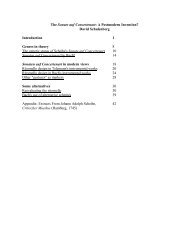SEVEN PAPERS ON EXISTENTIAL ANALYSIS ... - Wagner College
SEVEN PAPERS ON EXISTENTIAL ANALYSIS ... - Wagner College
SEVEN PAPERS ON EXISTENTIAL ANALYSIS ... - Wagner College
You also want an ePaper? Increase the reach of your titles
YUMPU automatically turns print PDFs into web optimized ePapers that Google loves.
They will demand another approach to the human way of be-ing, which is so different from that<br />
of the other mammals.<br />
What Existential Psychotherapy Is Not<br />
Let us turn again to some basic questions. Perhaps a comparison of existential psychotherapy<br />
with other forms of psychotherapy will at least show what it is not. What is meant today by<br />
existential psychotherapy? How is existential psychotherapy related to psychoanalysis and the<br />
forms of psychotherapy rooted in humanistic psychology? Here we may be brief, since the story<br />
has been told countless times.<br />
The unique character of existential psychotherapy is often overlooked, especially when it<br />
is thought of as a modified form of psychoanalysis. Orthodox psychoanalysis is marked by the<br />
controlled regression of the analysand during analysis. This is a delicate procedure that is risky for<br />
individuals whose ability to discern the difference between consensual reality and private or<br />
personal reality is tenuous or impaired. When fantasies become powerful, such individuals may<br />
be unable to anchor their fantasies to the relatively unyielding realities of everyday life, including<br />
the therapist. Even analysands with fairly strong ego functioning often experience great anxiety<br />
during periods of regression. However, unless there is sustained regression for extended periods<br />
of time, the treatment may be a form of psychotherapy but it is not psychoanalysis.<br />
While the origins of psychotherapy lie well before Freud and the invention of the "talking<br />
cure," the near history of psychotherapy begins, of course, with psychoanalysis and the<br />
treatment, by two Viennese physicians of the several forms of hysteria that they, Josef Breuer<br />
and Sigmund Freud, described in a series of Studies on Hysteria published in 1895. Hysteria was<br />
then defined as a neuropathic disorder fit for diagnosis and treatment by psychiatrists, whose<br />
specialization in a branch of medicine determined how hysteria was conceptualized. We recall<br />
that, for a medical doctor, in order for pathology to be confirmed, an observable lesion<br />
(damaged tissue) or physiological dysfunction has to be identified. The treatment of the<br />
disease, which is named only when a lesion has been identified, is based on its etiology. The<br />
source of the ailment is treated, not only its symptoms. Palliative treatment is temporary while<br />
the organism, now given the advantage, heals itself. In the absence of a lesion, however, no<br />
etiology can be named, no cause of the illness can be identified, and no treatment justified. It<br />
is then just a matter of guesswork, and that is not medicine.<br />
Freud was certain underlying neurochemical disorders would eventually be discovered<br />
to explani the neuroses he named and classified. In a series of letters to a rhinologist friend of his<br />
in Berlin, Wilhelm Fliess, he also described likely cellular anomalies of cortical functioning that<br />
might account for the neuroses. A very capable histologist, he thought he was on solid ground<br />
in hypothesizing neurological pathology, although he admitted that the lesions of the nervous<br />
system that produced hysteria and neurasthenia were too subtle to be seen at the time he<br />
investigated them. At the present time, at the end of the twentieth century, we see more, and I<br />
have not doubt that Freud would have been delighted by the findings of neuroscience.<br />
Freud's treatment, however, and not his discussion of the causes of the diseases he had<br />
discovered, was revolutionary. In a sense, he need not have been a medical doctor to do what<br />
he did as a psychotherapist. This is why he was not opposed to lay analysts. The “talking cure”<br />
was the work of a philosopher. Freud conceptualized mental disorders as diseases of the brain,<br />
but he treated them as though they were problems of living or disturbances of the soul. He<br />
limited his method to the psychoneuroses – hysteria, anxiety neurosis, obsessional neurosis and<br />
neurasthenia – and believed that the more severe disorders of the personality, know collectively<br />
at his times as the psychoses, were untreatable by his method. Unlike some of his followers,<br />
beginning with Carl Gustav Jung, he kept his distance from dementia praecox or schizophrenia<br />
unless his investigation was buffered by time and the absence of the patient, as in the case of<br />
his study of Hofrat Paul Schreber.















